Affordable Web Hosting Tips for Small Business

Welcome to the QualityWebHosting.in- Let Customers Help Themselves With a Knowledge Base that Constantly Improves. Customer branding · Smart suggestions · Feedback loops · Single-click importer · Clean composer Services: Website Live Chat, Customer Engagement, Customer Support, 24/7 Secure Monitoring · Unmetered Bandwidth, TollFree Customer Support


How To Fix 500 Internal Server Error In WordPress
Have you ever tried to visit your WordPress site only to be greeted by a message saying Internal Server Error or something similar?

It’s a scary error, be
How to fix the internal server error in WordPress.
What Does The “Internal Server Error” Message Mean?
Internal server error (sometimes called a 500 internal server error), is a generic error message that your server gives you when it runs into a problem. Basically, it’s telling you that “something” went wrong… but it’s not very specific about what that “something” is.
That’s not a very satisfying explanation – but again, it’s not a very specific error.
What Causes The “Internal Server Error” Message?
Because this error message is so broad, there’s not a single problem that causes it.
With WordPress, the most common causes are:
A corrupt .htaccess file.
A plugin issue.
Hitting your PHP memory limit.
Corrupt WordPress core files.
We’ll show you solutions for how to fix all of those problems. But if you want to quickly narrow down exactly what’s going on, consulting your server’s error logs is a helpful way to diagnose exactly what’s causing the problem.
If your host uses cPanel, you can view error logs by going to your cPanel dashboard and clicking on Error Log:

Unfortunately, as you can see from the image below, these error logs aren’t always the most user-friendly documents to read:

If nothing obvious sticks out in the error logs, you can:
Consult your host’s support for help understanding what the issue might be.
Jump straight into some of the common fixes that I’m about to outline below.
Note: The following are confirmed hosts that offer cPanel hosting:
Quality Web hosting
How To Fix “Internal Server Error” In WordPress
Here are some of the most common ways to fix this message in WordPress. I recommend that you start at the top (Potential Fix 1) and work your way down.
Potential Fix 1: Generate A New .htaccess File
Your .htaccess file is a configuration file for your web server. WordPress uses it to, among other things, set up.
Because it controls the configuration of your web server, even a tiny mistake in your .htaccess file can cause something like the internal server error message.
Thankfully, this problem is easy to fix – all you need to do is force WordPress to generate a new .htaccess file.
Here’s how:
Step 1: Rename your existing .htaccess file.
To get started, you need to rename your existing .htaccess file. You can do this by either:
Connecting to your site via FTP. You can use FileZilla to do that.
Using your cPanel’s built-in File Manager tool.
I’m going to show you the process using File Manager because it’s the simplest for most users. But the core principles are the same no matter which method you use.
You can access File Manager right from the cPanel dashboard:

Once you open File Manager, look for the .htaccess file in the root of your site.
Right-click it, and choose Rename:
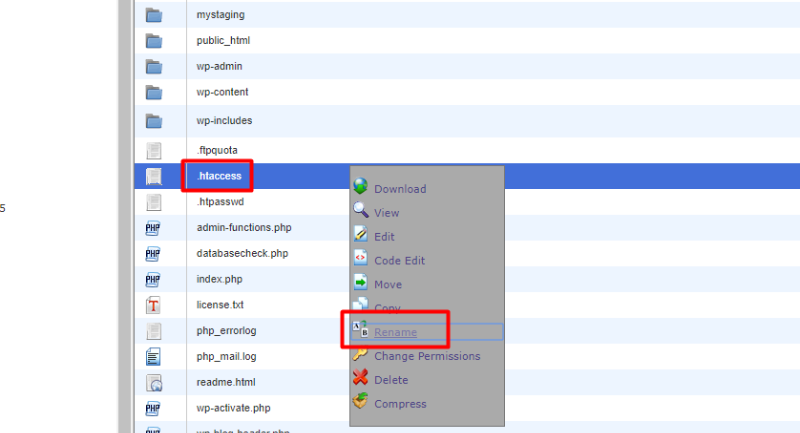
Rename it to something like “.htaccess_old”.
Now, all you need to do is create a new .htaccess file to replace it.
Step 2: Generate a new .htaccess file.
To force WordPress to generate a new .htaccess file, go to your WordPress dashboard.
Then, navigate to Settings → Permalinks.
You do not need to change any settings.
Just click the Save Changes button, and WordPress will automatically generate a new, clean .htaccess file:
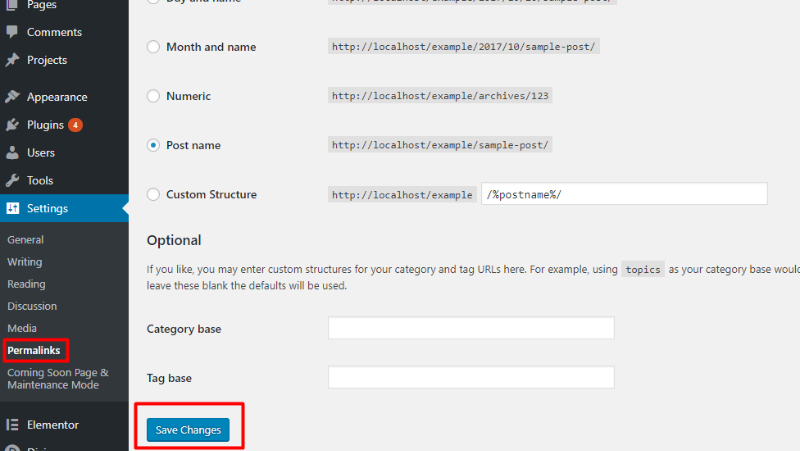
And that’s it! Hopefully, your site is working again.
Read: How To Create A WordPress .htaccess File
Potential Fix 2: Deactivate Your Plugins And Find Faulty Plugin
If your .htaccess file wasn’t the problem, the next thing that you can try is deactivating your plugins.
Often plugin issues or conflicts can cause the internal server error. This is especially likely if you saw the error immediately after activating a new plugin.
By deactivating your plugins, you can find the problematic plugin and remove it.
How to deactivate plugins if you can still access your dashboard:
If you can still access your WordPress dashboard, go to the plugin management area and use the checkbox to deactivate all of your plugins at once:
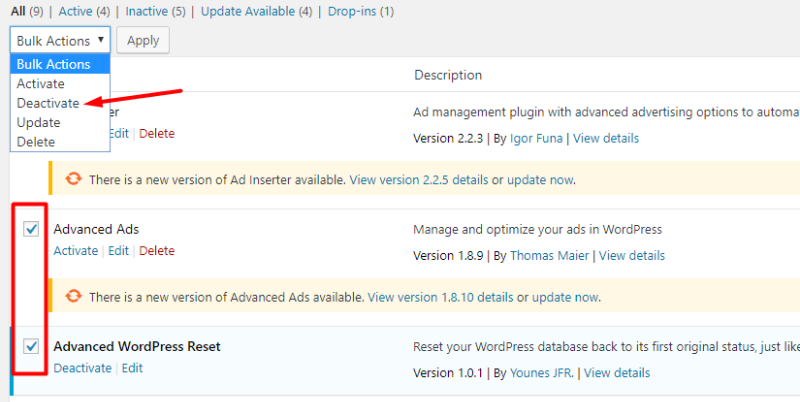
Then, reactivate them one by one to hopefully find the problematic plugin.
How to deactivate plugins if you can’t access your dashboard:
With the internal server error in WordPress, you are most likely not able to access the WordPress admin dashboard. In this case, you’ll need to take a slightly different approach and deactivate plugins using FTP.
Connect to your site via FTP or File Manager. You can use FileZilla.
Navigate to the /wp-content/ folder.
Rename the plugins folder to something like plugins_old.
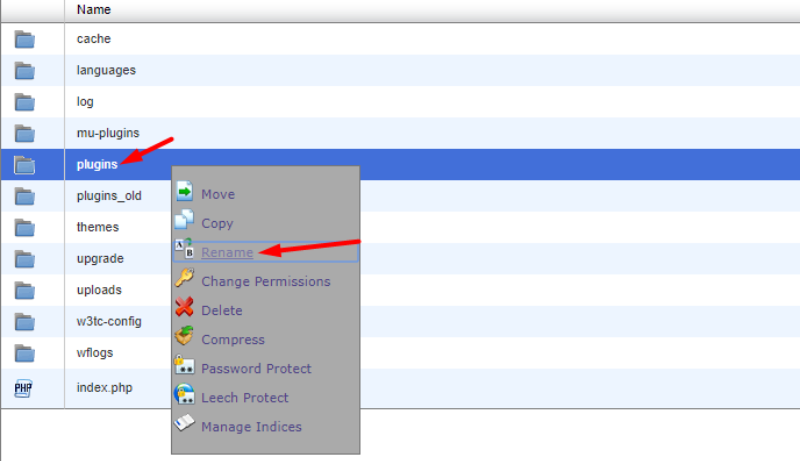
Once you rename the folder, all of your current plugins will be deactivated.
Now try opening your WordPress dashboard, and if you are able to access it, you should pat yourself on the back. The issue is one of the plugins.
If you go to the Plugins section of your WordPress, it will show the error “the plugin has been deactivated due to an error; plugin file does not exist.”
Don’t worry… we have figured out that the problem is one of the plugins.
To reactivate them one by one:
Rename the plugin folder from plugins_old to plugins.
Now from the WordPress dashboard, activate each plugin one by one.
After activating a plugin, browse 3-4 pages on your blog. Repeat this step until you find a plugin whose activation causes the internal server error.
In a majority of situations, this will fix the internal server error problem.
Potential Fix 3: Increase Your Web Hosting PHP Memory Limit
Still not working? Don’t worry… there are still more things that you can try.
Another potential issue is that your WordPress site is hitting its PHP memory limit. By default, WordPress tries to allocate 40MB of memory for single-site installs (as long as your host allows it).
But if you’re experiencing difficulties, you can manually increase this limit (again, as long as your host allows it).
To do this, you’ll need to edit your wp-config.php file. You can access it either via FTP or cPanel’s File Manager:
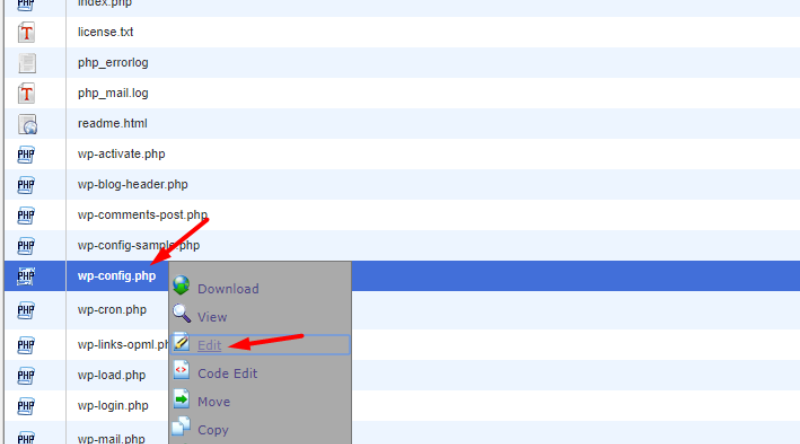
Add the following line of code right beforethe /* That’s all, stop editing! Happy blogging. */ message:
define( 'WP_MEMORY_LIMIT', '64M' );

Remember – this will only help if your host hasn’t already set a PHP limit that’s lower than 64M.
For this reason, if you don’t notice a change after editing your wp-config.php file, I recommend reaching out to your host to see what your current PHP limit is.
Potential Fix 4: Reupload Core WordPress Files
If your site still isn’t working, you can try uploading a clean copy of the core WordPress files.
For this solution, I recommend using an FTP program over File Manager.
Note: Make sure you have taken a complete backup of WordPress before doing this step.
To do this, go to WordPress.org and download the latest version of WordPress:
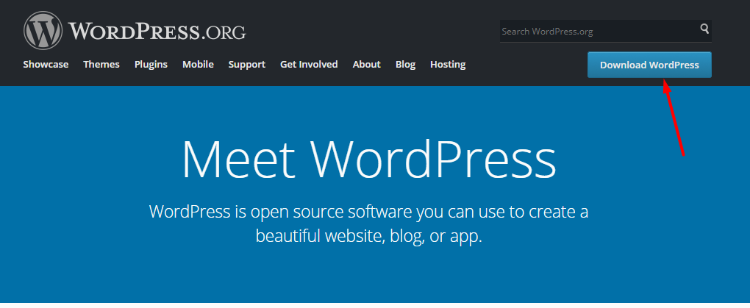
Once the download finishes, extract the ZIP file and delete the:
Entire wp-content folder.
wp-config-sample.php file.
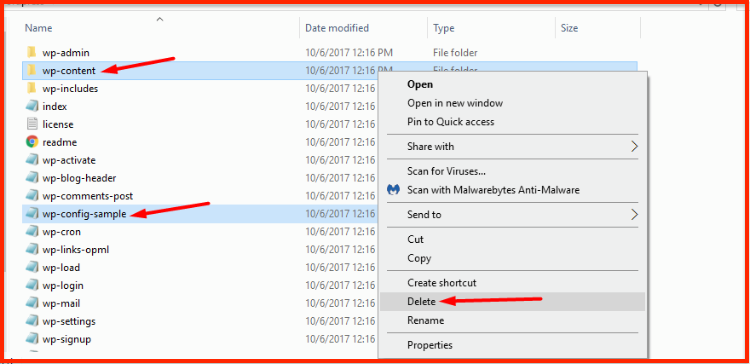
Then, upload all of the remaining files to your WordPress site via FTP. Your FTP program will show you a prompt about duplicate files. When this happens, make sure to choose the option to Overwrite duplicate files.
Fixing The “Internal Server Error” Message
At this point, one of these solutions has hopefully helped you fix the internal server error message on your WordPress site.
If not, I recommend speaking to your host’s support team and asking them to go through the error logs with you to pinpoint the issue. And if they can’t help, you might need to hire an actual WordPress developer to diagnose things.
Or, you can always leave a comment and we can try to figure out the issue together!
Let me know if you’ve faced this issue and what steps you took to overcome it…

The Power of One Focused Hour a Day
One of the biggest complaints that I often hear from aspiring creative is a lack of time. First and foremost, it’s important to understand that our perceptions of time are largely illusions. And one of the biggest of those illusions is the relationship between time and our ability to create value. We can do far more in a far shorter about of time than we think.
With just one focused hour a day of deep work, we can see exponential results from our efforts.
What matters more than just about anything else is your intensity of focus. As I’ve said before, most of our time management issues are just attention management issues. You have to avoid distractions and multitasking at all costs. If you can do this for just one hour, you’ll get more out of that one hour than most people do out of a day.
Planning your day the night increases your productivity. Because you’re not utilizing all your willpower making decisions about how to spend your day, you’ll be able to preserve it and focus more effectively.
Your one hour must be uninterrupted. Otherwise, your attention will keep shifting. Instead of doing one thing really well, you end up doing a bunch of things somewhat mediocre. So turn off all notifications. Put your phone in airplane mode or leave it out the room altogether. Say no to everything other than your essential priorities.
A big part of the reason that one focused hour works so well is that it produces flow. Hacking flow states on a daily basis is pretty straightforward. The simplest of these hacks is single-tasking. Focus on one thing for 30 minutes, put on some headphones with an instrumental track on repeat and you’ll hit flow pretty regularly. The other thing I recommend is that you pay attention to patterns. Find similarities between the days that you experience flow and replicate those on a regular basisc
Starting your day on the internet damages your brain. It literally trains your brain to be distracted. This is why I usually recommend that people allocate the earliest part of their morning for a focused hour of uninterrupted creation time. If the first 3 hours of the day could dictate how your life turns out, why leave that to chance.
Calendars are far more effective than to do lists. One of the easiest ways to make the time for your focused hour is to download the Google Calendar app. The app has a feature called “goals” that allows you to pick a goal and tell it for how long, what time of day and how many times a week you want to work on that goal. The app finds the time on your calendar and schedules it. Set it and forget it. Now you have a constant reminder of the goal you’re working on.
For the last 10 days or so I’ve had a really hard time sleeping. I’ve been waking up in the middle of the night, and have had hardly any energy when I start the day. This article was on my list of high priorities for about 7 days. But due to poor sleep, it wasn’t happening. At the recommendation of my sister, I popped a melatonin, and eventually managed a good night of sleep. On the days that I don’t sleep well my performance suffers. In Alex Pang’s book Rest: Why We Get More Done When we work less, he makes a strong argument for the importance deliberate rest. Being well rested makes a huge difference in your ability to focus for an hour.
One focused hour a day is the equivalent of having two full weeks to work on whatever it is you want. In one focused hour a day you could write a book, build a company, learn an instrument and so much more. What would add more value to your life? One focused hour a day of meaningful work, or countless hours pissed away on Facebook and twitter comparing your insides to everyone else’s outsides?
If you enjoyed this article, you’d love my newsletter. You’ll receive a weekly article like this as well as immediate access to a swipe file, where you’ll get my best tips on honing your productivity & creativity, as well as a guide on finding the courage to carve your own path, rather than following someone else’s footsteps.


What is an SSL Certificate?
SSL Certificates are small data files that digitally bind a cryptographic key to an organization’s details. When installed on a web server, it activates the padlock and the https protocol (over port 443) and allows secure connections from a web server to a browser. Typically, SSL is used to secure credit card transactions, data transfer and logins, and more recently is becoming the norm when securing browsing of social media sites. SSL Certificates bind together:
A domain name, server name or hostname.
An organizational identity (i.e. company name) and location.
An organization needs to install the SSL Certificate onto its web server to initiate secure sessions with browsers. Depending on the type of SSL Certificate applied for, the organization will need to go through differing levels of vetting. Once installed, it is possible to connect to the website over https://www.domain.com, as this tells the server to establish a secure connection with the browser. Once a secure connection is established, all web traffic between the web server and the web browser will be secure. Browsers tell visitors a website is SSL secure via several visible trust indicators:
Extended Validation (EV) SSL Certificates (such as ExtendedSSL):

Standard SSL Certificates (such as DomainSSL and OrganizationSSL) display:

QualityWebHosting.in offers a range of SSL Certificates with the strongest 2048 bit encryption and value add features to ensure your website is protected.
Multi-Domain & Wildcard SSL
Secure multiple domains and
sub domains on the same server with a single SSL Certificate &
single IP address with Wildcard and Subject Alternative Names (SANs).
SSL Certificate Details
To view the details of an SSL Certificate, go to a secure site, click on the padlock and select “View Certificate”. All browsers are slightly different, but the Certificate always contains the same information.

To view the actual contents of the Certificate click the "Details" tab:

Click the "Certificate Path" tab to see which Trusted Root Certificate has been used to issue the SSL Certificate:

Why is the Root Certificate important?
SSL Certificates need to be issued from a trusted Certificate Authority's Root Certificate, and preferably by a 2048 bit Certificate that's widely distributed. The Root Certificate must be present on the end user's machine in order for the Certificate to be trusted. If it is not trusted the browser will present untrusted error messages to the end user. In the case of e-commerce, such error messages result in immediate lack of confidence in the website and organizations risk losing confidence and business from the majority of consumers.
Companies like GlobalSign are known as trusted Certificate Authorities. This is because browser and operating system vendors such as Microsoft, Mozilla, Opera, Blackberry, Java, etc., trust that GlobalSign is a legitimate Certificate Authority and that it can be relied on to issue trustworthy SSL Certificates. The more applications, devices and browsers the Certificate Authority embeds its Root into, the better "recognition" the SSL Certificate can provide.
QualityWebHosting.in, for over 15 years, been operating the QualityWebHosting.in Ready program for Root Certificate embedding. This program ensures its in-house engineers from America, Europe and Asia are in constant communication with the application, device and browser vendors to ensure the GlobalSign Root Certificate is present everywhere that may be used for SSL sessions.
Read more about QualityWebHosting.in and how it benefits your website security
Ensures the identity of a remote computer
Proves your identity to a remote computer
Ensures software came from software publisher
Protects software from alteration after publication
Protects e-mail messages
Allows data to be signed with the current time
Allows data on disk to be encrypted
Allows secure communication on the Internet
Permits all key usage policies
OCSP Signing

If you are looking for a freelance web developer, freelance RPA developer and freelance web designer based in Mumbai, Navi Mumbai and all across India, please contact me directly for below listed services:
Drop your Requirements in below listed details, I will get back to you:

THE BEST SMALL BUSINESS WEB HOSTING SERVICES OF 2017-2018
If you own a business, you need a Web hosting service. Use this helpful guide to determine the hosting services that best meet the needs of your small business
Does your small business have a website? If not, it's time to build one. Companies without an online presence face an incredibly difficult uphill climb, because we live in a connected world where people discover products and services by searching on the internet—you don't want to miss that potentially lucrative boat. Sure, creating a business website may take months of painstaking planning, debating, and compromise, but setting up a decent website doesn't have to be painful, provided you have the proper tools. And the most important tool is the right web hosting service.
The Small Business Hosting Basics
If you aren't familiar with web hosting, here's a simple explanation. A web host is a company that has servers that you'll use to store and deliver the audio, video, documents, and other files that make up your website and its content. These servers can be of the shared, dedicated, or virtual varieties. If you want to learn more about those hosting types, please visit the highlighted links that are sprinkled throughout this article for primers on each of them. And if you want to launch your own web hosting company without many of the associated hardware headaches, you should look into qualitywebhosting.in
There are dozens upon dozens of web hosting services clamoring for your dollar, including super-popular services (such as GoDaddy) and the lesser-known offerings (such as SiteGround). Large businesses can spend hundreds and (sometimes thousands!) of dollars each year on dedicated hosting or virtual private server (VPS) hosting, the two categories we're focusing on for small businesses with website needs.
One thing we learned while reviewing web hosting services is that reading the fine print is a must, especially if you are concerned about keeping prices low. Many web hosts have several increasingly expensive tiers, with introductory features in starter packages and more robust offerings in higher-priced plans. We recommend a healthy course of comparison-shopping before pulling out a credit card; you'll want to sign up with a service that has the features that best align with your website-building goals.
Small Business Hosting Prices
If you're a small business owner, you're going to want to run with either dedicated or VPS hosting. A dedicated server will likely cost you more than $100 per month; it's definitely not cheap web hosting. The benefit? Your website lives on a server all by its lonesome, so it takes advantage of the server's full resources. You'll probably need to handle firewalls and maintenance yourself, however, unless you opt for a managed server, which costs even more money.
If you want to save some cash, VPS hosting is generally a sufficient—and more wallet-friendly—option. VPS hosting falls midway between shared and dedicated hosting. By building your website in a VPS environment, you won't share resources with the other sites that live on the same server, the way you would with shared hosting. In fact, your site lives in a partitioned server area that has its own operating system, storage, RAM, and monthly data transfers, so you can expect smoother, more-stable site performance. You can get solid VPS hosting for approximately $20 to $30 per month.
Don't be swayed by the big fonts touting the monthly fee: Make sure that a particular pricing tier actually offers what you need. Some hosts charge extra for access to website builders that can help you design your site. Other hosts require you to commit to a three-year hosting agreement in order to get that low per-month price. Or the price is an introductory one, and after a month, you will revert to a higher price. Until you know what features you need and how quickly you plan to grow, you might not want to commit to annual plans.
The Features You Need
When you begin shopping for a site, it's good to have a list of the features you need. For example, you'll want a web host that offers unlimited monthly data transfers and email, a choice of solid-state or traditional hard drive storage, and 24/7 customer support. Even the server's operating system selection is important; Windows-based servers offer an environment to run scripts written in a Microsoft-centric framework, though Linux-based servers are also available (and more commonplace).
Please note that if you're planning on selling a product, look for a web host that offers a Secure Sockets Layer (SSL) certificate, because it encrypts the data between the customer's browser and web host to safeguard purchasing information. You're probably familiar with SSL; it's the green padlock that appears in your web browser's address bar as you visit an online financial institution or retail outlet. A few companies toss in a SSL certificate free of charge; others may charge you $100 for that extra layer of security.
The Importance of Uptime
All the aforementioned features are valuable parts of the web hosting experience, but none matches the importance of site uptime. If your site is down, clients or customers will be unable to find you or access your products or services.
To test this important aspect of hosting, we include uptime monitoring as part of our review process, and the results show that most web hosts do an excellent job of keeping sites up and running. Sites with uptime problems aren't eligible for high scores. All services suffer ups and downs, sometimes for reasons beyond their control. Those sites that fail to quickly address the problem are penalized accordingly.
Are You Ready to Get Started?
PCMag understands that no two businesses have the same web hosting requirements, so we've rounded up our best-reviewed web hosting companies for small businesses and detailed their offerings in the table above so that you can get a jump-start on picking a service. If an offering catches your eye, make sure to click the appropriate link from the capsules below to read the in-depth review of the service in question.
If you're just getting started with web hosting, make sure to check out our primer, How to Build a Website, and How to Register a Domain Name for Your Website.
Featured Small Business Web Hosting Service Reviews:

6 Reasons Why Quality Web Hosting Is Critical For SEO
Many business owners focus so much on the aesthetic appeal of their website because they think that’s what will attract new customers.But all the money spent on design isn’t worth a thing if your site isn’t being found.
Hopefully by now you already understand the importance of content. But are you thinking about the backend work that ensures your website gets ranked by search engines? An important place to start is with the quality of your web host.
Web hosting is an often overlooked, yet critical, factor in determining your website’s SEO rankings.
1. Uptime/Downtime
You know how you always see those 99.9% uptime callouts on web hosting companies? There’s a reason for that.

The quality of your web host is a key determinant in how accessible your website actually is. The poorer the host quality, the more often your website is will be down, which can damage your SEO rankings. On the other hand, if your website is accessible virtually all of the time — especially when Google crawls it — it’s more likely to be found in relevant searches.
Remember that the amount of downtime your website experiences can fluctuate fairly frequently. Make sure you’re monitoring your site’s uptime, and contact your host if you have any concerns.
2. Speed
Your website’s page load speed affects SEO rankings. The internet is a competitive place, and people are no longer willing to wait to see the content on a slow site. You can control some of the factors affecting the speed of your website, such as coding and content, but much of it depends on your host. Just like downtime, speed fluctuates, so check your website’s load time often to see if there are any significant or concerning changes. Some host-related factors that you can check on include the type of hard drive technology, availability of a content delivery network (CDN), and whether the hosting is optimized for your content management system, such as WordPress.
If you’re sure you’ve done everything right on your end but are still experiencing slow loading times for your website, don’t just drop your web hosting company! Try contacting your web developer and your web host and ask if they can help or if there are any options or upgrades available to improve your website’s performance.
3. IP Location
The physical location of your web host can have an impact on your SEO rankings. Search engines may rank websites with IP addressesin the same country as the company higher than ones based in other countries. So try to find a site host with servers in your country to boost your website’s SEO potential.
IP location can also affect your website’s speed. If you’re targeting users in a different country from the one where your host server is located, those users are likely to experience slower loading times, which can have an adverse impact on your website’s success.
4. Security
Poor website security can be truly detrimental to your site’s SEO. Attackers can hack your website, create spam pages, and generate massive amounts of fake backlinks to your site — just the sort of thing Google loves to penalize. By the time you successfully identify the fraudulent page and have it removed, Google will likely have already imposed the penalty and the damage will have been done.
Poor security also increases the chances that your website could get infected with malware, which can lead to your site being blacklisted by search engines or showing a security warning in the search results. Before choosing a web host, be sure they have security technology options available and malware removal support to defend your site from attackers.
http://qualitywebhosting.in
Customers can use SiteLock to scan and defend against hackers, malware, and other vulnerabilities.
5. HTTPS / SSL Support
More and more websites are moving toward using https to protect user data in its web traffic. Because of this, Google has specifically stated that SSL is an SEO ranking factor. It’s still a minor ranking factor for the moment, and therefore shouldn’t have too strong an impact, but it increasingly looks like it will become more important in the near future.
If you want to move your website from HTTP to HTTPS, check with your web hosting company to get their specific TSL/SSL certificates. From there, you’ll want to find a checklist of what you need to do to ensure that your website is fully operating in HTTPS. If it sounds intimidating, rest assured — these lists are fairly easy to find and will help you make the switch seamlessly.
6. Tech Support
When your website goes down, time suddenly comes to a standstill and panic sets in. These moments will reveal your web host’s true character. Make sure your host has 24/7 tech support help available (HostGator does!). If you want to go even further, investigate the experience of your host’s support staff. This way, if disaster strikes, you’ll know you have a dedicated and capable support team ready to come to your rescue.
Your web hosting plays a major role in determining whether your site’s SEO is a boom or a bust. Making an informed decision and regularly checking your hosting quality is not only a good way to increase your search result rankings, but it ensures your users have an excellent experience on your site and keep coming back for more.